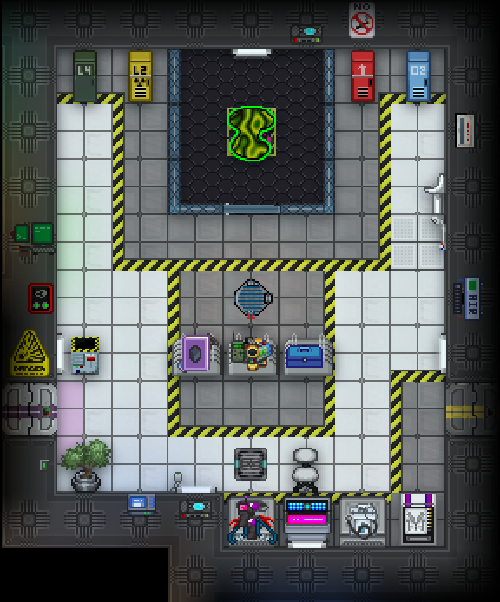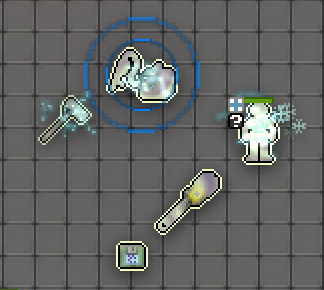User:Racc-Off/new artifacts: Difference between revisions
No edit summary |
|||
| (11 intermediate revisions by the same user not shown) | |||
| Line 1: | Line 1: | ||
[[File:Xenoarchaeology workspace.png|frame|right|The Xenoarchaeology Lab. Artifacts tend to show up here.]] | |||
'''WIP''' | |||
== Artifacts [[File:artifact_bananium.png]] [[File:artifact_uranium.png]] [[File:artifact_plasma.png]] [[File:artifact_bluespace.png]] == | == Artifacts [[File:artifact_bananium.png]] [[File:artifact_uranium.png]] [[File:artifact_plasma.png]] [[File:artifact_bluespace.png]] == | ||
Artifacts are powerful and mysterious ''items'', they are responsible for many phenomena including transforming people into corgis, or spontaneously creating missing persons cases. | Artifacts are powerful and mysterious ''items'', they are responsible for many phenomena including transforming people into corgis, or spontaneously creating missing persons cases. | ||
| Line 5: | Line 9: | ||
=== Anatomy === | === Anatomy === | ||
<hr> | |||
Defining an artifact starts with its '''material'''. An artifact's material defines what 'rules' it follows in terms of what kind of traits it can have, and how many traits it can have. | Defining an artifact starts with its '''material'''. An artifact's material defines what 'rules' it follows in terms of what kind of traits it can have, and how many traits it can have. | ||
<div class="mw-collapsible-content"> | <div class="mw-collapsible-content"> | ||
| Line 48: | Line 53: | ||
=== Traits === | === Traits === | ||
<hr> | |||
<div class="toccolours mw-collapsible mw-collapsed"> | <div class="toccolours mw-collapsible mw-collapsed"> | ||
Trait List ('''mouse over the sleuth entries for a brief explanation''') | Trait List ('''mouse over the sleuth entries for a brief explanation''') | ||
| Line 79: | Line 85: | ||
=== Acquiring === | === Acquiring === | ||
<hr> | <hr> | ||
Obviously you'll need an artifact first, before you can begin research. Artifacts can be bought through | Obviously you'll need an artifact first, before you can begin research. Artifacts can be bought through the Research and Development Listing Console [[File:Xenoartifact_console.png]] with the science budget, which will deliver artifacts through cargo. Otherwise, artifacts can be 'found', or even [[#The Work | made]]. | ||
Artifacts can be found on [[Lavaland | lavaland]], inside [[Maintenance| maintenance]], or during [[Exploration Crew| exploration missions.]] | |||
''Making'' artifacts is a little bit tricker, and will require some sleuthing from the player to figure out. | |||
=== Labelling === | === Labelling === | ||
| Line 88: | Line 96: | ||
=== Processing === | === Processing === | ||
<hr> | |||
Once the artifact is labeled, you have several options on how you'd like to process it. | Once the artifact is labeled, you have several options on how you'd like to process it. | ||
| Line 100: | Line 109: | ||
== The Work == | == The Work == | ||
How to perform the work | [[File:Thework.png|frame|right|Products of The Work.]] | ||
The work is a process players ''can'' figure out for themselves in-game, and we encourage them to do so, but for those who can't quite figure it out- | |||
<div class="toccolours mw-collapsible mw-collapsed"> | |||
'''How to perform the work''' | |||
<div class="mw-collapsible-content"> | |||
Look at you lmao! | |||
</div> | |||
</div> | |||
== Misc == | |||
=== Defense === | |||
Knowing how to defend yourself against particularly dangerous artifacts is a key step to keeping yourself outside medbay. In terms of avoiding the effects of artifacts, certain techniques and clothing will keep an artifact from being able to target you. | |||
* The tile directly under arua, timed, flammable, etc. artifacts isn't actually targeted, and is the safest place to be in most cases. | |||
* Clothing and armor like syndicate hardsuits and wizard robes have a chance to deflect artifact targeting. Here's a ''definitely'' accurate list of which clothings block artifacts, and their chance to do so. | |||
<div class="mw-collapsible-content"> | |||
{| class="wikitable sortable" style="width:50%; text-align:center; margin-left:20%" border="1" align="center" cellspacing="0" cellpadding="2" | |||
! scope="col" style='background-color:#6f55ad;'|Clothing | |||
! scope="col" style='background-color:#6f55ad;'|Block Chance | |||
|- | |||
!{{anchor|Bluespace}}[[File:clown.png]] Blood-Red Hardsuit | |||
|100% | |||
|- | |||
!{{anchor|Bluespace}}[[File:clown.png]] Gem-Encrusted Harsuit | |||
|100% | |||
|- | |||
!{{anchor|Bluespace}}[[File:clown.png]] Prototype Hardsuit | |||
|100% | |||
|- | |||
!{{anchor|Bluespace}}[[File:clown.png]] Bio Suit | |||
|75% | |||
|- | |||
!{{anchor|Bluespace}}[[File:clown.png]] Radiation Suit | |||
|100% | |||
|- | |||
!{{anchor|Bluespace}}[[File:clown.png]] Wizard Robe | |||
|100% | |||
|- | |||
!{{anchor|Bluespace}}[[File:clown.png]] Fake Wizard Robe | |||
|75% | |||
|- | |||
|} | |||
</div> | |||
Latest revision as of 02:04, 23 July 2024

WIP
Artifacts 



Artifacts are powerful and mysterious items, they are responsible for many phenomena including transforming people into corgis, or spontaneously creating missing persons cases.
Science can research with these items to gain various rewards, including both research and discovery points.
Anatomy
Defining an artifact starts with its material. An artifact's material defines what 'rules' it follows in terms of what kind of traits it can have, and how many traits it can have.
The next aspect is an artifact's traits. Traits define an artifact's behaviour and characteristics, these traits fall into 1 of 4 categories, of which are-
| Trait Type | Info |
|---|---|
| Activators | These define how an artifact 'activates'. Every artifact will have 1 of these. |
| Minors | These can define an artifact's physical characteristics, special secondary actions, or artifact function behaviour. Every artifact will have 3 of these. |
| Majors | These define an artifact's action, what it does. Every artifact will have 1 of these. |
| Malfunctions | These define what's wrong with an artifact. Most artifacts will not start with these, instead gaining 1 through repeated use without stabilization. |
Traits
Trait List (mouse over the sleuth entries for a brief explanation)
Research
As stated earlier, science can research with these items to gain various rewards.
Acquiring
Obviously you'll need an artifact first, before you can begin research. Artifacts can be bought through the Research and Development Listing Console ![]() with the science budget, which will deliver artifacts through cargo. Otherwise, artifacts can be 'found', or even made.
Artifacts can be found on lavaland, inside maintenance, or during exploration missions.
Making artifacts is a little bit tricker, and will require some sleuthing from the player to figure out.
with the science budget, which will deliver artifacts through cargo. Otherwise, artifacts can be 'found', or even made.
Artifacts can be found on lavaland, inside maintenance, or during exploration missions.
Making artifacts is a little bit tricker, and will require some sleuthing from the player to figure out.
Labelling
Once you have an artifact, you'll need to label it![]() , correctly, for it to have any value whatsoever. This is generally done by sleuthing out what traits the artifact has by examining, weighing, conducting, and generally testing it, which can be done with various items. If you don't want to accidentally activate the
, correctly, for it to have any value whatsoever. This is generally done by sleuthing out what traits the artifact has by examining, weighing, conducting, and generally testing it, which can be done with various items. If you don't want to accidentally activate the bomb artifact while doing this, be sure to wear a pair of anti-tactile pinchers ![]() , these will make most interactions safe, but only if they are enabled. Otherwise, activating the artifact, although dangerous, can also help you sleuth out what traits it has.
, these will make most interactions safe, but only if they are enabled. Otherwise, activating the artifact, although dangerous, can also help you sleuth out what traits it has.
It's important to be wearing science goggles![]() during this process, as they will generally translate vague hints and effects into exact trait names.
during this process, as they will generally translate vague hints and effects into exact trait names.
Processing
Once the artifact is labeled, you have several options on how you'd like to process it.
Stabilizing
Stabilizing an artifact stops it from malfunctioning, and doubles any potential rewards gained from it. This is useful for artifacts you want to distribute across the station, without the risk of blowing a hole in the hull, or just maximizing profits before selling it. Successfully stabilizing an artifact will reward science with a small amount of discovery points.
Exporting
Exporting, selling, an artifact through cargo will not only give cargo a monetary kick back for doing your dirty work, it also awards science with research and discovery points.
Tracking
Once an artifact is stabilized, instead of selling it you can opt to 'track' it instead. Tracked artifacts will generate research and discovery points when activated, and, if enabled, will announce their location of science comms.
The Work

The work is a process players can figure out for themselves in-game, and we encourage them to do so, but for those who can't quite figure it out-
How to perform the work
Look at you lmao!
Misc
Defense
Knowing how to defend yourself against particularly dangerous artifacts is a key step to keeping yourself outside medbay. In terms of avoiding the effects of artifacts, certain techniques and clothing will keep an artifact from being able to target you.
- The tile directly under arua, timed, flammable, etc. artifacts isn't actually targeted, and is the safest place to be in most cases.
- Clothing and armor like syndicate hardsuits and wizard robes have a chance to deflect artifact targeting. Here's a definitely accurate list of which clothings block artifacts, and their chance to do so.